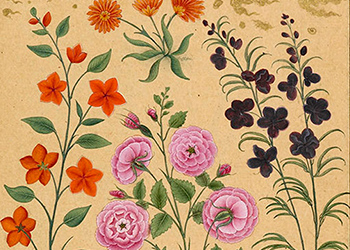The Emperor’s Flowers

The floral designs ornamenting these examples emerge out of the dialogues between the East and the West over the course of the 17th century and provide the pretext for this seductive voyage that relives the fascination elicited by the exotic bulbs and flowers in the West.
This fascination drove the study and description of these plants, the publication of illustrated botanical compendiums as well as the planting in Europe of gardens with collections of Asian flowers, exotic trees and other rare plants, which endowed prestige and a sense of distinction upon their owners. Visitors would flock from all over to admire the acacias of Egypt, the pepper trees of the Indias, the sunflowers, yuccas, aloes, tulips and fritillaries, among many other species.
In order to perpetuate these collections, many volumes of great beauty, richly illustrated by renowned artists, were published. Organised whether by botanists, typographers, gardeners or florists, these volumes reached increasingly diversified and curious audiences. Brought along by European ambassadors, missionaries and traders in their respective diplomatic, religious and commercial missions, some of these volumes would have reached the far distant Mughal court where many of the flowers therein depicted had long since been known and admired.
Recent studies point to the representations of plants in these volumes as the source of inspiration for designs carried out by some local artists and thus establishing elements for a new decorative grammar in the East, for which these carpets represent a fascinating example.
The carpets of India in the Gulbenkian Collection
The Calouste Gulbenkian Museum carpet collection is made up of eighty-five works, above all from Persia, India and the Caucuses, which were mostly acquired between 1907 and 1939. As regards the Indian carpets, the collection contains six examples of the Mughal period. All of these carpets, produced in royal and urban workshops, display an extremely high level of technical and artistic quality, thus also demonstrating the mastery and sophistication attained by the weavers of this period.
The Emperor’s Flowers
From the Bulb to the Carpet
Founder’s Collection and the Lower Floor Gallery
9 February-21 May 2018
Curators: Clara Serra, Teresa Nobre de Carvalho
